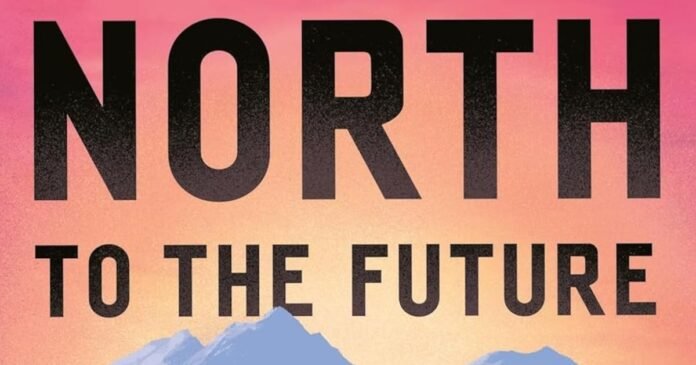“North to the Future: An Offline Adventure Through the Changing Wilds of Alaska”

By Ben Weissenbach; Grand Central Publishing, 2025; 301 pages; hardcover $30, ebook $14.99, audiobook $27.99.
When Ben Weissenbach was an undergrad student at Princeton, he studied with John McPhee and became enamored with McPhee’s 1976 book “Coming Into the Country.” While still an undergrad, he received a university journalism grant, which he applied to a loosely conceived project involving interviewing interesting Alaskans, following McPhee’s example. In the summer of 2018 he met Roman Dial, the renowned adventurer, mathematician, biologist and APU professor, and accompanied him on a moose hunt. That led to two lengthy science expeditions through the Brooks Range with Dial, in 2019 and 2021.
In addition to these, Weissenbach also spent considerable time with Kenji Yoshikawa, a reindeer-herding permafrost expert, and Matt Nolan, an independent glaciologist who studies Alaska’s Arctic glaciers. He could hardly have found more “interesting” Alaskans than these three or presented them, his relationships with them and their work in more fascinating terms. He refers to the three as part of “a small and hardy group … in a kind of scientific Wild West.”
Weissenbach, from Los Angeles and now a Ph.D. candidate in polar studies at Cambridge, identifies himself early in the book as a member of “the first generation to go through adolescence with front-facing cameras.” He’d grown up spending “an ungodly number of hours” on the internet and practically no time outside, with the “perennially distracted mind of a digital native.” Uneasy in that world, he sought to disconnect from the “dinging and buzzing” to see what life might be like in a place where people were not similarly distracted and “did things instead of just talking about them.”
Weissenbach’s book title, “North to the Future,” sounds like the cliche it’s long been for promising exploitation and riches. It takes a bit of settling in to realize that the author’s use of it is ironic, and that the future he suggests is an almost dystopian one of environmental change. Almost, because he presents the science he learned in all its complexity and surprises, as a process that asks questions and is constantly revised.
The one accepted fact is that the north of Alaska has been warming much faster than most of the rest of the planet, resulting in significant changes to weather, plant growth, animal movements, the freeze-thaw cycle and human lives. Weissenbach documents this through his direct experience in the Arctic along with reporting on the work of the scientists he accompanied and further research, including that related to earlier explorers and scientific studies.
The two expeditions with Dial — one through the eastern Brooks Range from the Dalton Highway to the Canadian border and the other from the central Brooks Range west, eventually to the community of Kivalina — were for the primary purpose of documenting treeline and the degree to which vegetation was moving north as a result of climate change. Satellite photos show a northward “greening,” but it was the Dial group’s feet-on-the-ground, weekslong treks through remote terrain to collect the data that details treeline advances in specific places, conditions and degrees.
Along the way, Dial and his hand-picked students observed and recorded many other examples of environmental change — among them sloughing banks, drying wetlands, drained lakes and rivers running red with iron released by thawing permafrost.
Weissenbach carefully and clearly describes how treeline movement will influence not just the biology of the north and the migrations and feeding patterns of animals but climate change itself. While trees (and other vegetation) sequester carbon they absorb from the air, they also darken the earth to hold, rather than reflect, heat from the sun. The net effect of this is still under study.
Apart from the adventuring — the bear encounters, river crossings, fierce storms and injuries — and the science, the delight in “North to the Future” is to be found in the portraits Weissenbach constructs of those he gets to know. Employing vivid scenes with frequent dialogue and finding humor in every situation, he truly brings to life his “characters.”
Dial is perhaps the best drawn character, in all his eccentricities, demands and generosity. As they approached the starting point for the first expedition, the author writes, “’I hope this all works,’ mused Roman. ‘It seems pretty improbable, doesn’t it?’” Soon, sharing a small tent with a fragile zipper that required highstepping through a restricted top opening, and with the group’s food cache stored between them, Weissenbach realizes, “If I was going to last six weeks in a tent with Roman, one of us would have to change, and it wasn’t going to be him.”
Throughout, Weissenbach, a skilled observer and self-aware writer, remains acutely conscious of what he does and does not know about the world around him. Drawn to the tundra as a “blank spot on the map,” what he soon found “was not an absence, but a pungent mesh of spongy mosses, neon lichens, and leafy greens. An entanglement of life that resembled, in its vivid color and complexity, a terrestrial coral reef.” Looking closer, more came into view. “Hundreds of tiny trees, a new generation no more than a few years old, bristled up through the soil.”
In our age of alienation from genuine experience and the natural world, it’s refreshing to come upon a young person, open to being tested and fortunate in his encounters, who inspires by his example. Many dream of adventure; few actually seek it. Fewer still can turn experience into artful and informative storytelling. John McPhee, to whom the book is dedicated, is surely proud of his former student.
[Book review: A journey through polar science helps explain our living world and its future]






